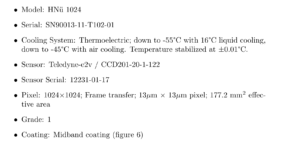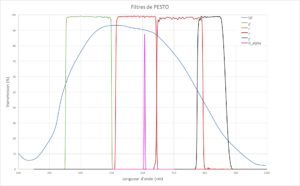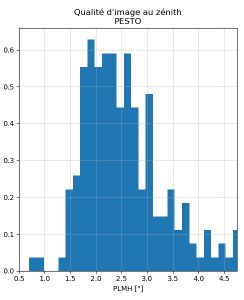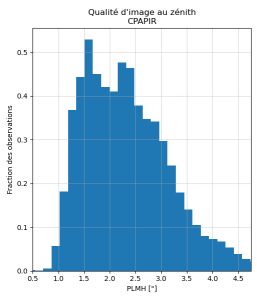Instruments’ Guide
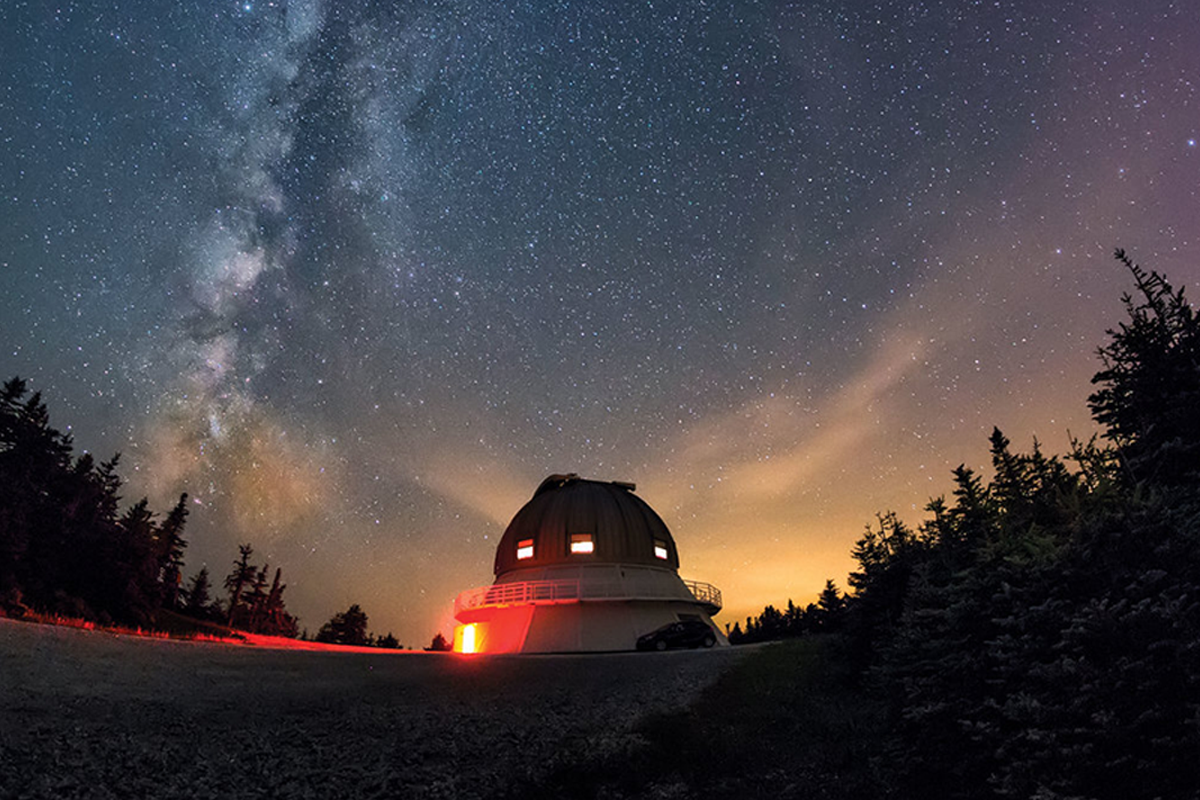
PESTO
Instrument Features
Available filters
There are 6 filter positions available. The filters available are: g’, r’, i’ z’ and Halpha, produced by ASTRODON (photometric sloan filters).
Additional filters can be added quickly during missions.
Filter size is 1.25″ (3.175cm).
| Filtre | λ nm | Δλ nm | |
| g’ | — | 401-550 | |
| r’ | — | 562-695 | |
| i’ | — | 695-844 | |
| z’ | — | 826-920 | |
| Hα | 656.3 | 3 |
Observing modes
Image Quality at Zenith (FWHM)
Acknowledgements
All articles using PESTO data must include the following statement:
“Based on observations obtained with PESTO at the Mont-Mégantic Observatory, funded by the Université de Montréal, Université Laval, the Natural Sciences and Engineering Research Council of Canada (NSERC), the Fond québécois de la recherche sur la Nature et les technologies (FQRNT) and the Canada Economic Development program.”
Les publications PESTO
| Rappaport, S. et al., 2017,Monthly Notices of the Royal Astronomical Society, Volume 471, Issue 1, p.948-961 | WD 1202-024: the shortest-period pre-cataclysmic variable |
Questions? Feel free to contact us!
David Lafrenière : david.lafreniere@umontreal.ca
CPAPIR
Basic instrument characteristics
| Field of view (OMM) | 30’x30′ |
| Pixel scale (OMM) | 0.89″/pixel |
| Detector | 2048 x 2048 pixels, Hawaii II |
| Minimum integration time | 1.35 s |
| Integration time is always a multiple of 1.35 s | |
| Overhead per exposure | 5 s |
| Overhead per dither (<30″) | ~5-10 s |
| Overhead for slews of more than a few arcminutes | ~30-45 s |
| Median Full Width at Half-Maximum (FWHM) at the OMM | 2.0″ |
| Readout noise | ~10 electrons |
| Linearity imit | ~30 000 ADU per coadd |
| Gain | ~2.5 e-/ADU |
| Transmission | 30-35% |
Available filters
CPAPIR two filter wheels can only hold up to 10 filters. Filters will be changed depending on the semester’s requests.
| Filter | λ | Δλ |
| J | 1.25 μm | 0.16 μm |
| Paβ | 1.2814 μm | 0.012 μm |
| CH4 | 1.57 μm | 0.05 μm |
| H | 1.65 μm | 0.30 μm |
| CONT2 | 2.033 μm | 0.025 μm |
| HeI | 2.062 μm | 0.015 μm |
| CIV | 2.081 μm | 0.02 μm |
| H2 | 2.122 μm | 0.023 μm |
| Ks | 2.15 μm | 0.30 μm |
| Brackett γ | 2.165 μm | 0.02 μm |
| HeII | 2.192 μm | 0.04 μm |
| CONT1 | 2.255 μm | 0.10 μm |
Getting started with your CPAPIR proposals
Here is the relevant information the you should include in your CPAPIR proposal :
If you proposal includes more than one target, you should prioritize them.
The required exposure time may be estimated from the values listed in the table below. As a rule-of-thumb, the limiting magnitude increases as 1.25×log(T) and decreases with the seeing as 2.5×log(FWHM). The 5σ limiting magnitude for observations taken under a 2.5″ seeing and a total exposure time of 2 hours in J band will therefore be
19.4+1.25×log(7200s/600s)-2.5×log(2.5″/2″)=20.5.
This estimate has a 0.3 mag accuracy in J and 0.5-1.0 mag in H and Ks.
| Filter | 5 σ sensitivity FWHM=2.0″ t=600s |
| J | 19.4 |
| H | 17.5 |
| Ks, outside temperature > 10C | 16.5 |
| Ks, outside temperature < -5C | 18.0 |
Length of individual exposures
Please follow the exposure times suggested bellow. If you wish to use exposure times that differ significantly from the ones below, please contact us before submitting your proposal. It is not possible to read subarrays of CPAPIR’s detector at a high cadence, this feature is only available on Hawaii-II RG arrays.
J band : 1 co-addition of 20 s
H band : 2 co-additions of 10 s
Ks band : 3 co-additions of 8 s
narrow bands : 1 co-addition of 60 s
As a general rule, the per co-addition median of your images should not be above 10 000 ADUs as you would loose significantly in dynamic range. If the background is above 30 000 ADUs per coadd, your dataset will probably be useless!
Image quality constraints
Observing conditions at the Observatoire du Mont-Mégantic are typical of a continental site with a 2.0″ median seeing measured with CPAPIR (including the instrumental PSF). If the angular resolution is important to meet your science goals, you may add as a constraint that the observation be done only under a seeing better than the 2.0″. Of course, this constraint will decrease the likelihood that your observations be completed. The histogram of full width at half maximum values for the whole dataset of CPAPIR observations taken at the OMM is available below. The estimated FWHM without instrumental degradation assumes an instrumental contribution of 1.2″.
Timing constraints
Queue mode observations allow time-constrained observations, but you must remember that a good fraction of the nights are lost to clouds. Certain types of time-constrained observations are nevertheless well suited for this mode, such as exoplanet transit followups that have many timing windows through the semester. If you which to submit such a proposal, please submit an ascii table of the observing windows (UT time) with your proposal.
For other types of timing constraints, please contact us before submitting your proposal.
Dither pattern
You must specify the dither pattern for your observations. Your project most likely will fall within one of these four categories:
Photometry of a single source
If you wish to get the best photometric accuracy for a single point source, the dither pattern will only be within a 30″x30″ box. This strategy minimizes the effects of flat field illumination and may reach a photometric accuracy of a few milimagnitudes for bright targets.
Stellar field without extended source
If you observe a stellar field without any extended (>1′) object, we will use a 5’×5′ dither pattern. This pattern will give a uniform sensitivity through the field and good sky subtraction.
Extended object smaller than 15′
If your field has extended objects (more than 1′ but less than 15′), we will use a dither pattern that moves the target in the four corners of the field. This strategy gives a good sky subtraction while always keeping the target within the field.
Extended object larger than 15′
If your target takes more than half the field of CPAPIR, sky frames off the field will have to be taken. In that case, the required exposure time will be doubled, and you must double the requested exposure time for your proposal.
Data reduction
The Université de Montréal LAE’s team developped a data reduction pipeline for the analysis of CPAPIR datasets. In addition to your raw data, you will receive fully reduced data with astrometric and photometric calibration.
Photometric calibration
With CPAPIR’s wide field of view, there will always be numerous 2MASS stars in every frame (50 at galactic poles, 15 000 toward the galactic center). The catalog can be used to derive a reasonably precise photometric calibration to the percent level of all datasets. Observations can be obtained under light clouds without having to observe a flux standard. This calibration is included in the CPAPIR data reduction pipeline. Note that the CPAPIR’s J filter is significantly narrower than the 2MASS J filter and avoids the telluric absorption beyond 1.34 μm. CPAPIR uses a ‘MaunaKea’ (Jmko) J filter. For L and T dwarfs, this introduces a photometric bias relative to the 2MASS photometry, please read this paper for more details on this matter.
Archival data
The CPAPIR data is archived, from 2005 up to today, to the Canadian Astronomy Data Centre. The data is corrected for astromtry (_SCI). You will find reduced and combined data as well (_SCIRED). Please note that the data reduction pipeline is not optimized for extended objects. Therefore, you will need to use a more appropriate method developped for galaxy or HII region on the _SCI data.
Acknowledgements
All paper using CPAPIR data must include the following note in the “Acknowledgement” section :
“Based on observations obtained with CPAPIR at the Observatoire du mont Mégantic, funded by the Université de Montréal, Université Laval, the Natural Sciences and Engineering Research Council of Canada (NSERC), the Fond québécois de la recherche sur la Nature et les technologies (FQRNT) and the Canada Economic Development program.”
CPAPIR publications
You need a few ideas for your CPAPIR proposal? Here are the publications that made use of CPAPIR data :
Questions? Feel free to contact us!
Étienne Artigau : artigau@astro.umontreal.ca

